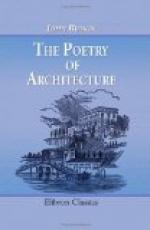161. It appears, then, from a consideration of these several points, that, in our antiquated style of villa architecture, some national feeling may be discovered; but in any buildings now raised there is no character whatever: all is ridiculous imitation, and despicable affectation; and it is much to be lamented, that now, when a great deal of public attention has been directed to architecture on the part of the public, more efforts are not made to turn that attention from mimicking Swiss chalets, to erecting English houses. We need not devote more time to the investigation of purely domestic English architecture, though we hope to derive much instruction and pleasure from the contemplation of buildings partly adapted for defense, and partly for residence. The introduction of the means of defense is, however, a distinction which we do not wish at present to pass over; and therefore, in our next paper, we hope to conclude the subject of the villa, by a few remarks on the style now best adapted for English scenery.
V.
THE ENGLISH VILLA.—PRINCIPLES OF COMPOSITION.
162. It has lately become a custom, among the more enlightened and refined of metropolitan shopkeepers, to advocate the cause of propriety in architectural decoration, by ensconcing their shelves, counters, and clerks in classical edifices, agreeably ornamented with ingenious devices, typical of the class of articles to which the tradesman particularly desires to direct the public attention. We find our grocers enshrined in temples whose columns are of canisters, and whose pinnacles are of sugar-loaves. Our shoemakers shape their soles under Gothic portals, with pendants of shoes, and canopies of Wellingtons; and our cheesemongers will, we doubt not, soon follow the excellent example, by raising shops the varied diameters of whose jointed columns, in their address to the eye, shall awaken memories of Staffa, Paestum, and Palmyra; and in their address to the tongue, shall arouse exquisite associations of remembered flavor, Dutch, Stilton, and Strachino.
163. Now, this fit of taste on the part of our tradesmen is only a coarse form of a disposition inherent in the human mind. Those objects to which the eye has been most frequently accustomed, and among which the intellect has formed its habits of action, and the soul its modes of emotion, become agreeable to the thoughts, from their correspondence with their prevailing cast, especially when the business of life has had any relation to those objects; for it is in the habitual and necessary occupation that the most painless hours of existence are passed: whatever be the nature of that occupation, the memories belonging to it will always be agreeable, and, therefore, the objects awakening such memories will invariably be found beautiful, whatever their character or form.




